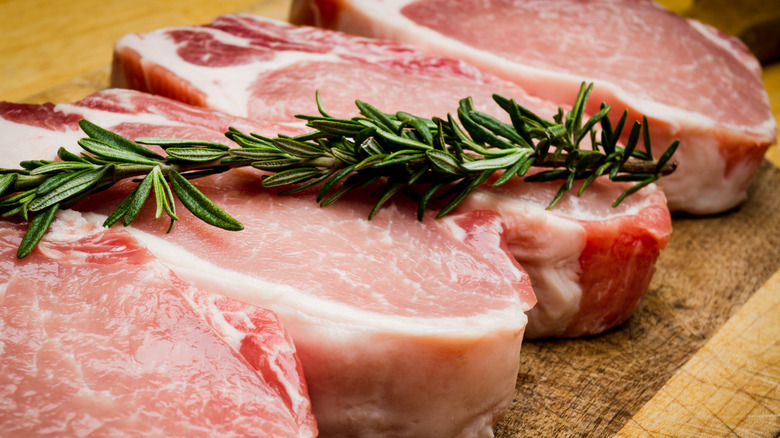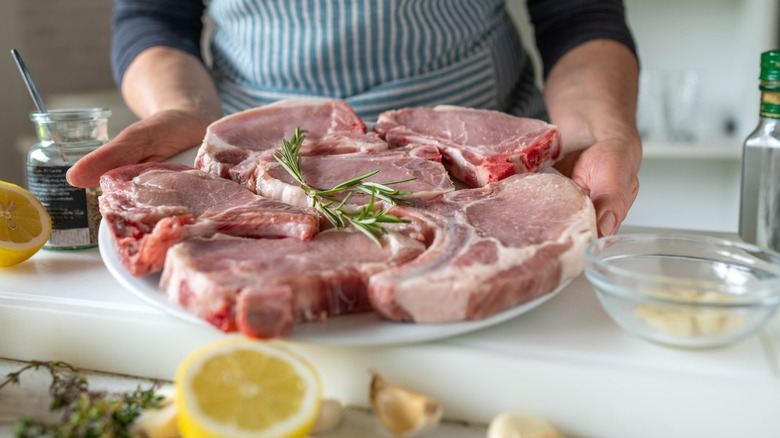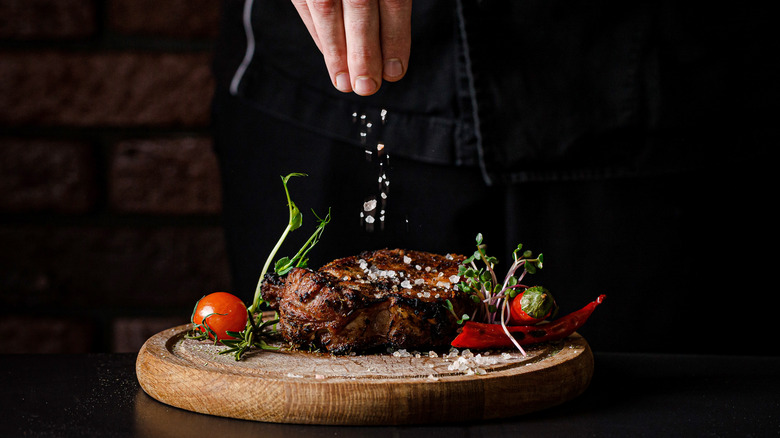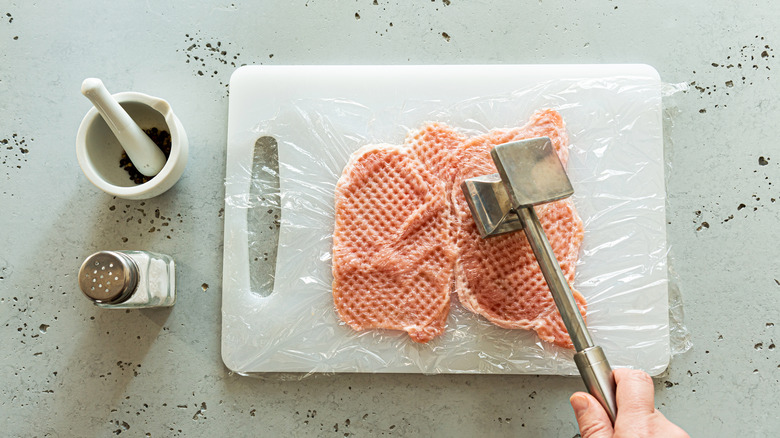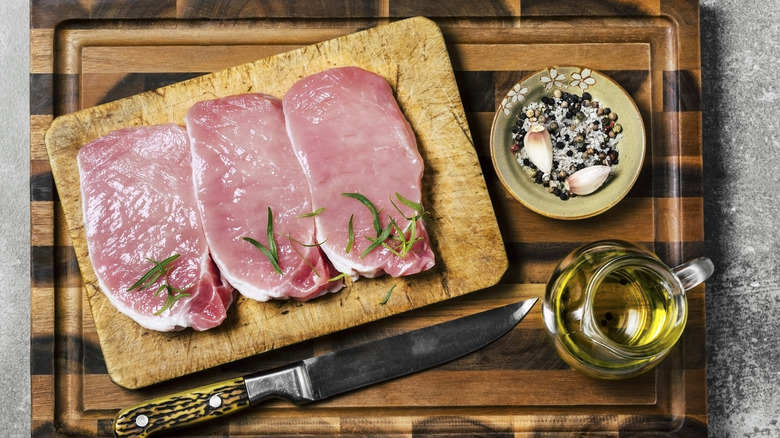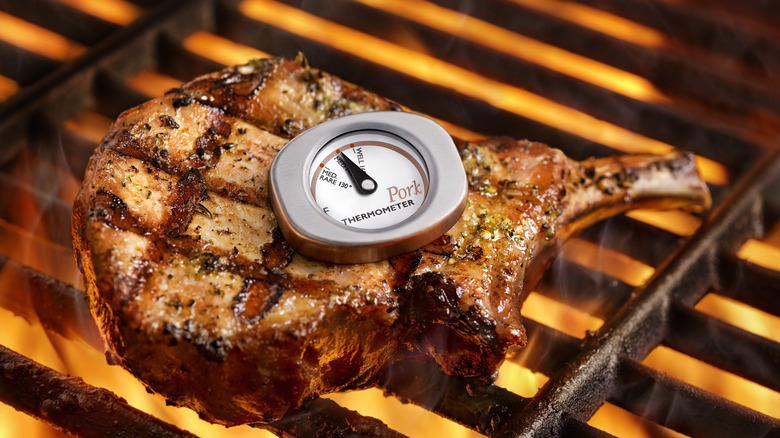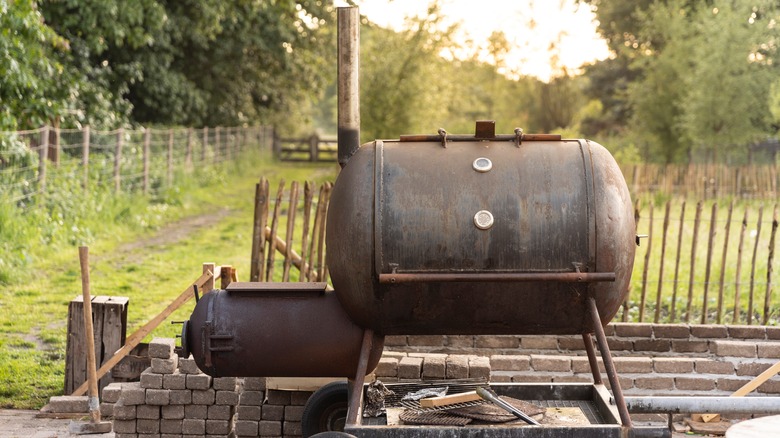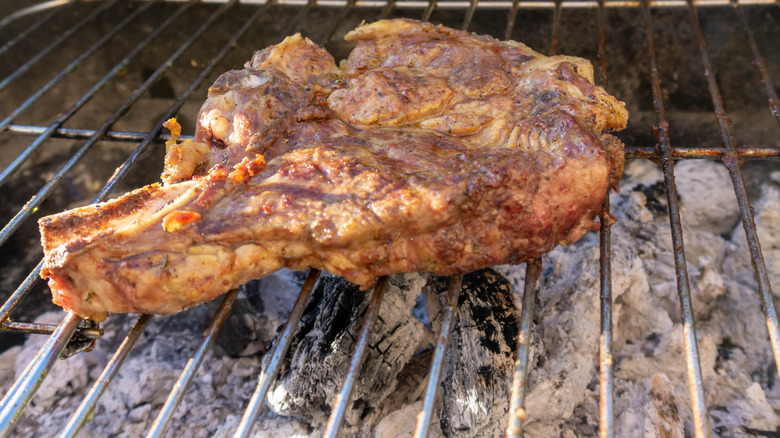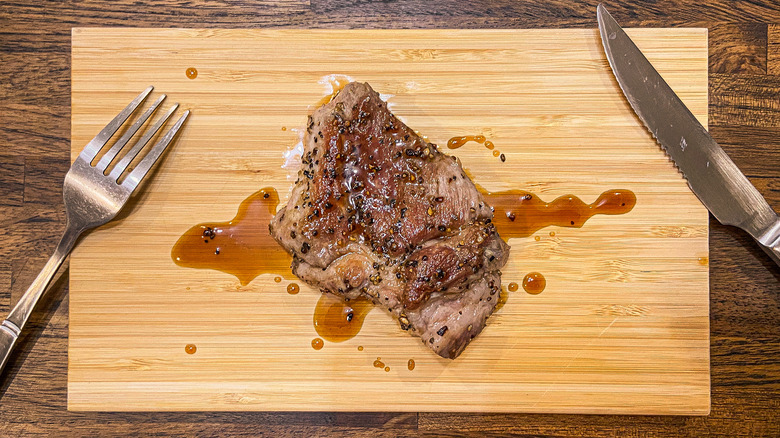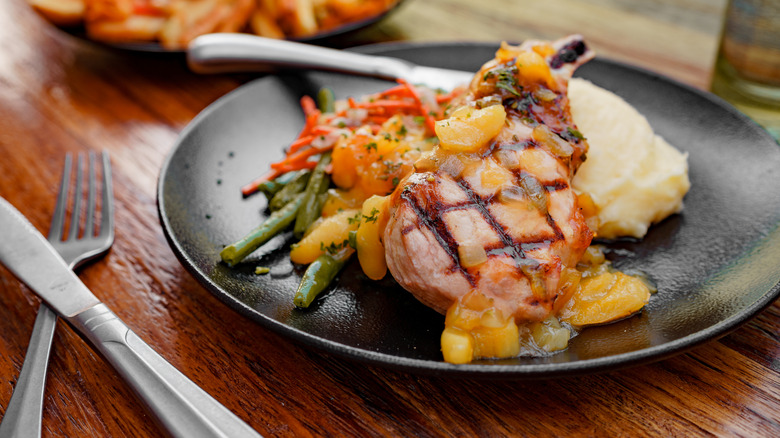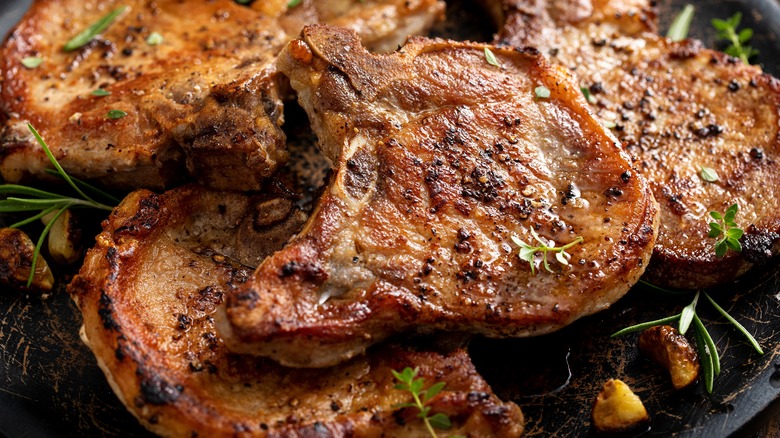All Your Burning Questions About Grilling Pork Chops, Answered
With grilling season in full effect, being able to serve up some perfectly cooked meats is crucial. Of course, one does not need to be a grill master to make a rave-worthy outdoor meal, but it is important to know the golden rules of grilling – from prepping and cooking to allowing your protein to rest before serving.
When firing up your barbecue, it is also important to know how to grill your chosen protein or cut of meat since not all proteins cook alike. In fact, grilling pork – especially pork chops – can be tricky business if you want your chops to be fully cooked, juicy, and seasoned just right. And, if you do not have a lot of experience grilling pork chops, you may just ruin dinner. To avoid dry, tough, or undercooked chops and hangry barbecue guests, here are all your burning questions about grilling pork chops answered, along with some pro tips and sage advice from Max The Meat Guy.
What is the easier cut to grill – bone-in or boneless?
So, you have decided on pork chops for dinner, but first thing is first, you need to choose — bone-in or boneless? Bone-in pork chops are typically the easier cut to grill, as there is less room for error, and the results are simply delicious. "When possible, always opt for bone-in pork chops! The bone protects the meat from intense heat and will lead to a juicier final product," says Max. With a little seasoning and medium to high heat on the grill, you are basically good to go with bone-in chops.
In general, both options are lean, flavorful, extremely versatile, and work well as the star component in a variety of dishes. However, there are also obvious differences when it comes to texture and taste. Bone-in chops are often a popular go-to because they are a little fattier and reasonably priced. On the other hand, boneless chops cook fairly quickly and are ultra-lean — making boneless chops a nice no-fuss dinner option any day of the week. In the end, boneless chops are still worth considering if you are looking to whip up something last minute and do not mind the extra prep – but you need to be willing to keep a watchful eye on them, as boneless pork chops can become somewhat dry when grilled.
What is the secret to grilling up delicious pork chops?
Grilling up delicious pork chops every time does not have to be a rare occurrence, either. Of course, prepping your chops with flavorful marinades will always make for some tasty eats. But the secret to incredible grilled chops actually begins at the grocery store — you want to find top-tier cuts for an unforgettable meal. "Selecting a high-quality pork chop is key. Find one bone-in with a lot of marbling for better tenderness, juiciness, and flavor," says Max.
A good amount of marbling, which is basically fat intertwined with lean muscle, is the building block for a mouth-watering chop. Thus, in order to find quality chops with decent marbling, your best bet is to head to your local butcher shop, as they are more likely to have high-grade meats available. Once you have secured only the best pork chops, do yourself a favor and season the meat — a dash of salt and pepper can help to enhance the overall taste of your chops further. A generous sprinkling of spices and herbs pre-grill, in general, is a game changer and can also be used in addition to your homemade marinade.
Should you tenderize pork chops before putting them on the grill?
Since pork chops are a leaner protein, opting to tenderize before you put them on the grill can make a world of difference. However, if you purchased quality chops, then you can most likely skip this step, according to the pros. "Tenderizing pork chops is not necessary — if the pork chop is the same cut as a ribeye steak (loin pork chop), then it is naturally very tender," says Max.
Nevertheless, there are five different types of pork chops — rib, boneless, porterhouse, shoulder, and sirloin — so tenderizing a non-loin cut may be unavoidable, as they can be less tender or lack sufficient marbling. If you need to tenderize your lean cut of meat, there is more than one way to go about it. Common tenderizing methods for pork include softening with a meat mallet, marinating, brining, and braising (it is worth noting that braising is not typically recommended for the grill, however.) Most of these techniques work well for boneless pork chops but are not a must, especially if you are dealing with bone-in chops. When grilling your pork chops, be mindful of medium rack placement to prevent overdone meat.
When should you season pork chops before, during, or after they are grilled?
Seasoning pork chops should happen pre-grill. Adding your chosen spices and herbs before grilling your protein will not only help to keep the meat tender and juicy but it will also highlight or enhance a cut's overall savoriness. Since this particular cut of pork is somewhat bland on its own, the experts agree that you should season before cooking. "Always season pork chops prior to cooking," Max says. "If time allows, use a technique called dry brining."
Dry brining relies heavily – if not almost exclusively – on salt to transform your chops sans the water. Of course, this grill master-approved and beloved professional chef technique will require some extra prep-time. "To do this, season your pork chop at least one hour before cooking (ideally the day before). Once thoroughly coated, place the pork chops on a rack and put them, loosely covered, in the fridge," Max suggests. After a good dry brine, it is highly recommended that you remove any excess salt before cooking so remember to give your chops a quick wipe down and blot dry before grilling.
How long should you grill pork chops for?
If you do not have time to brine and are ready to fire up the grill now, there is no need to panic. A dash of your favorite spice blend is all it takes to get dinner started here. When it is time to transfer those well-seasoned chops to your pre-heated grill, you can expect to spend 2 to 3 minutes searing a sized chop on each side, on average. Depending on the size, thickness, and actual cut (shoulder, rib, boneless, sirloin, or loin chops), cook times may vary.
In addition to the time spent searing the meat, it may take several more minutes to grill smaller, boneless chops, which can have a total cook time of around 7 minutes. In contrast, for thicker, bone-in, and larger pork chops, a general cook time of up to 20 minutes is common (and this includes the time it took to get those chops properly seared).
What temperature is best for grilling pork chops?
As Max notes, it's important to pre-heat the grill before cooking. Before counting down the minutes until your pork chop dinner is ready, you will want to preheat your grill to roughly 375-400 F sooner rather than later. "Dry brining is key to achieving the perfect sear," says Max. "With less surface moisture, the pork chop will develop a flavorful crust when cooking, preventing any 'steaming' from occurring." Instead, what occurs is the Maillard reaction, the chemical process wherein surface proteins are changed into caramelized, friable edge we crave. In order to beautifully sear your chops, locate the hottest section of the grate on your grill and place your chops under direct medium to high heat, allowing a nice crust to build.
Once you have seared your chops on both sides, then move them away from the direct heat and continue to cook with indirect heat until an internal temperature of 145 to 160 F is reached. Regardless of whether you are using a gas, electric, or charcoal grill, pork is safe for consumption when it reaches 145 F, which is medium-rare. On the other hand, for a more well-done cut, an internal temperature of 160 F should be the goal. The easiest way to ensure you are serving up fully cooked chops that are grilled to your liking is by using a meat thermometer — so invest in one if you have not already.
Can you get the same intense flavors you get when you smoke pork chops versus grilling them?
For most barbecue lovers, grilling and smoking meats go hand in hand. However, these cooking methods yield slightly different results. This makes sense as grilling means using a direct heat source, while smoking relies on indirect heat. Plus, when you decide to cook pork chops on the grill, no one expects you to be outside for hours — hot and fast is the name of the game here. With a smoker, you can slow cook at lower temps while simultaneously upping the flavor profile of your cut of meat. So, what does this mean for your mouth-watering grilled pork chops, and is it impossible to get the same intense flavors you get when you smoke pork chops versus grilling them?
"There is no true substitute for real hardwood smoke flavor, but being selective with your seasoning can help," says Max. "When the pork chop is grilled, these coarse granules will toast up and provide aromatic and smokey flavors." Additionally, grilling your pork chops over wood fire can also add similar flavoring to that of a smoker, especially if you opt for hickory wood which is known to work wonders on other cuts of pork. Either way, matching the bold taste and unmistakably delicious barbecue smell that comes from smoking chops is impossible — you just need the right spices and the know-how to turn just about any grill into a smoker.
How can you avoid drying out your chops on the grill?
Nobody likes a dry pork chop, so how can you avoid drying out such a lean cut of meat? Minding cooking temperatures and keeping a watchful eye on your chops when cooking alfresco will help you avoid overcooking or burning your chops. Outside of these grilling basics, it all boils down to two previously mentioned steps — opting for a solid brining method and properly seasoning your pork chops.
This is the secret to achieving moist and juicy chops. For a traditional brine, 1 tablespoon of kosher salt and 2 tablespoons of granulated or brown sugar for every cup of water is really all you need. Adding other herbs or spices, like garlic, for instance, is also another way to infuse your chops with even more flavor. You can use a dry brine or simple marinade as alternatives.
After allowing your pork chops to marinate or brine for several hours, it is highly recommended that you pat the meat dry and season with a simple homemade rub. That said, if you are not a big fan of rubs or additional seasoning after brining, all you need to do after drying off your chops is use a little bit of olive oil, a pinch of salt (if so desired), and a touch of freshly ground black pepper. Following this two-step process will ultimately ensure you do not end up with dry pork chops.
Do you need to let pork chops rest after grilling?
Like with most proteins, letting your pork chops rest after cooking is another pro tip that should not be overlooked. "Let your grilled pork chops rest for roughly 5 to 10 minutes prior to slicing. In essence, treat your pork chop exactly like you would a high-quality steak," suggests Max. Also referred to as carryover cooking, this quick respite allows your meat to finish cooking away from a heat source.
With a thinner or boneless cut, you can let your chops rest for as little as 5 minutes before plating. Alternatively, for thicker (1 to 1½- inches), larger, or bone-in chops, a rest of approximately 8 to 10 minutes should do the trick. If you prefer your pork chops medium rare, it is perfectly acceptable to take them off the grill when they reach an internal temperature of 140 F or slightly below. This way, you can still achieve juicy and tender pork chop greatness, plus allow your protein to finish cooking without having it be overly done. Pro tip: before slicing, plating, and serving, double-check your chops internal temperature to ensure the thickest part of your meat has, in fact, reached 145 F. It will therefore be safe to consume.
What sides work best with grilled pork chops?
Once you have mastered the art of grilling pork chops, you can turn your focus to side dishes. Whether you are thinking of something simple like mashed potatoes, sautéed vegetables, or some combination of the two, there are some meal accompaniments that work super well with grilled chops. "Serving your pork chops with roasted pumpkin, sweet potato fries, or a fresh apple cider vinegar coleslaw, for instance, is always a hit," says Max.
But that's not all — from mac and cheese and collard greens to cornbread muffins and mango salsa, there is a wealth of side dish options to choose from when working with grilled chops. Since pork chops are versatile, there are really no wrong choices. That said, depending on your chosen seasonings, some dishes will likely pair better than others — so it is important to keep that in mind. Moreover, if you are short on time, it is perfectly acceptable to go with sides that are known to work well with just about any meal, such as broccoli dishes, green beans, and weekday dinner starches – rice, pasta, potatoes, bread, and more. The possibilities are truly endless when it comes to sides for this tasty cut of meat.
Are there any specific grilling tips one should know to make the perfect pork chop every time?
With a clear vision of your pork chop dinner in mind, the finish line is near, but what's the take-home here? A vital grilling tip that often gets overlooked when it comes to pork chops is the importance of thickness. You want to opt for a thicker chop to avoid overcooking. While you are at it, make sure to thoroughly season all sides of your thick chops for the best flavoring.
Another trick of the trade is to set up your grill for dual cooking – a hot side and a cool or cooler side – so you can quickly sear your chops and move them over to the cooler side of the grill to finish cooking. When it comes to searing, Max also has a few tips. "If the pork chop is thicker, then try your hand at reverse searing, which you can do by starting the cooking process on the cooler side of the grill," he says. "Cook until your pork chops reach about 100 F internal, then sear on the hot side (flipping frequently) until done." You will end up with the juiciest chops that fall right off the bone, thanks to this gradual cooking process. Ultimately, once you have the right chops, then it is all about going through the laid-out steps — brine, season, sear, grill, and rest before serving with some phenomenal sides.
